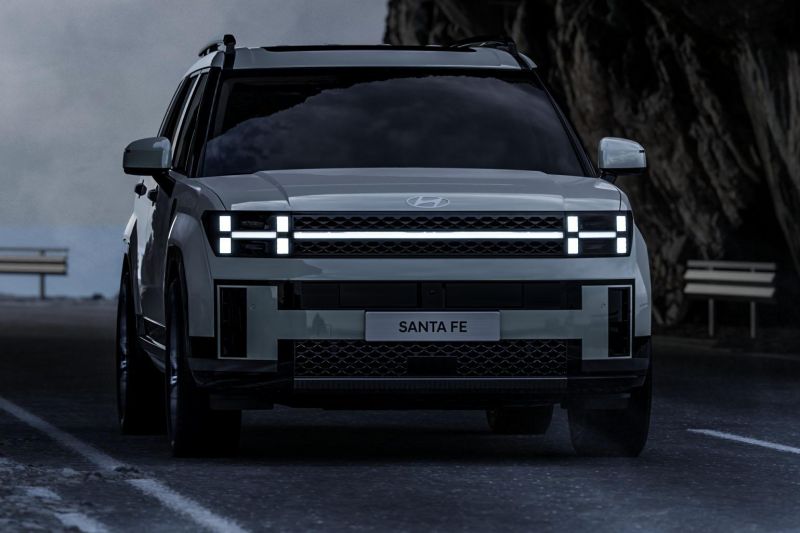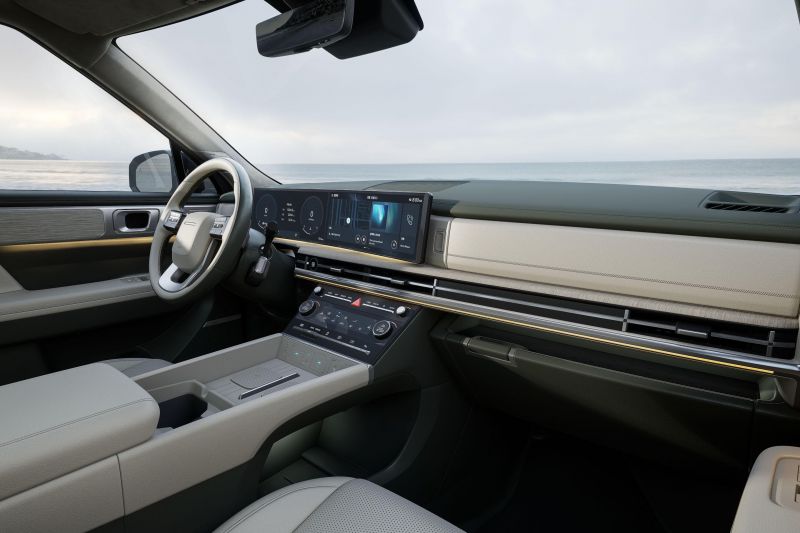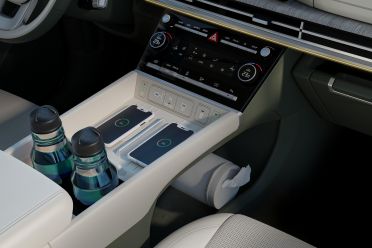After over a year of spy photos and leaks, the fifth-generation Hyundai Santa Fe has been unveiled, and it’s quite a departure from today’s car.
It’s due in Australia in the first half of 2024.
According to Hyundai, the new Santa Fe has undergone “radical transformation” with a “lifestyle-based design typology that maximises rear cargo capacity”, and “major updates shaped by big data around the latest outdoor lifestyle trends”.
If you’re not fluent in PR-speak, the crossover is bold, boxy, spacious, and slightly rugged.
Up front, the Santa Fe continues Hyundai’s recent trend of blending the headlights seamlessly into the grille. The headlamp units have a bold dot matrix-style H graphic, and are linked together with a light bar that stretches across the grille.
By blacking out the A-, B-, C- and D-pillars, the new Santa Fe has a floating roof look. Some models of the pictured here have been fitted with silver highlights on the C- and D-pillars, lending them a Land Rover Defender vibe.
The black out treatment has also been applied to the lower section of the front and rear bumpers, side sills, and around the wheel arches.
Top-spec models combine the standard angular wheel arches with 21-inch wheels to give the reborn fifth-generation Santa Fe an extremely robust stance.
Unusual design features continue at the rear, where the full width tail-light strip has been placed in the bottom third of the tailgate. Like the front, the tail-lights have graphics that look like a dot matrix H.
As the tailgate has no cut outs for the main tail-light strip, it lifts up as one giant rectangular slab, potentially making access to the boot a little easier. This design does, however, necessitate a secondary set of tail-lights to be placed in the bumper.
Hyundai says the new car has “class-leading interior space” thanks to a longer wheelbase, and second- and third-row seats that lie completely flat.
The exterior’s boxy theme is carried over into the interior, which mixes straight lines with soft-touch leather-like surfaces.
Hyundai says the cabin has been “inspired by natural light”, and the bright-coloured seats feature Nappa leather, while the door and dash have suede accents and wood-patterned panels.
A large curved rectangular slab houses a 12.3-inch instrumentation display, and a 12.3-inch infotainment touchscreen.
As with the exterior window graphics, the chunky four-spoke steering wheel has a strong Defender influence, with boxy shapes, a central airbag cover with a simple stripe in place of the Hyundai badge, and a column-mounted gear selector.
To go with “outdoor lifestyle” aesthetic, the Santa Fe has dials and large buttons on the dashboard. There is a small secondary touchscreen for the climate control system.
The centre tunnel features two wireless smartphone charging pads, two USB-C ports, two oversized cupholders, and an open-air storage underneath.
Recycled plastic material is used for the new Santa Fe’s faux suede headliner, floor mats, and second- and third-row seatbacks. Additionally the crash pad and door trim are covered in an “eco-friendly” leatherette.
No details about the car’s drivetrain options or exact dimensions were provided today. Presumably we’ll learn more about the new Santa Fe when the car has its official global launch in August this year.
The tailgate of one of the vehicles unveiled today does bear H-Trac and 2.5T badging, indicating the crossover will be available with all-wheel drive and a 2.5-litre turbocharged petrol engine.
Overseas, the current Santa Fe is available with a 2.5-litre turbo four-cylinder making 207kW and 422Nm. It’s likely the new car will be available with some version of that engine.
We expect the Santa Fe to be offered with hybrid and plug-in hybrid options again.
It will be interesting to see how the market reacts to the Santa Fe’s bold styling. To end of the June 2023, Hyundai has sold 3036 Santa Fes, placing it well behind its sibling Kia Sorento (5311) and rival Toyota Kluger (4658).
What do you think of the new Santa Fe’s design? Let us know in the comments section below.











